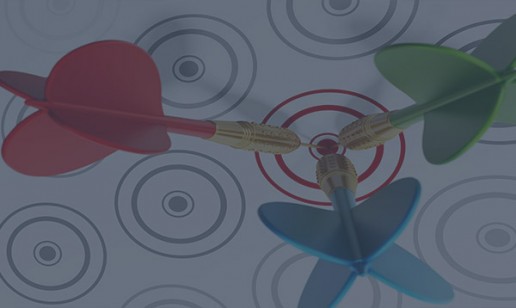How to Write Headlines that Actually Attract Attention
Headlines really matter if you want to attract those clicks and shares.
Copywriters know, whether it’s print or digital, that headlines are essential to your content’s success. The more people who read your catchy headline and have their interest piqued, the more likely they are to continue reading your content and even share it. In fact, David Ogilvy believed that headlines are worth 90% of advertising dollars.
So yeah, good headlines matter, a lot.
But writing awesome headlines that actually attract attention is a challenge even at the best of times for marketers and publishers. With that in mind, we’ve created an infographic that’s going to make your life easier – or at least, your headline writing life easier. Scroll down to learn the best practices now.

Want to learn more? Connect with our team at sales@clearpier.com
Lead Generation: 5 Simple Steps to a Smarter Strategy
These are the best practices for a fail-safe lead generation strategy.
So, you want to learn how to build a lead capturing machine and grow your business. Where do you start? How do you get your landing pages to perform?

What are the best practices for a fail-safe lead generation strategy? Keep reading and learn how to give your marketing strategy a boost now.
1. Define Your Goals and Target Audience
What’s the first step in creating a smart inbound marketing methodology that captures not just leads, but marketing qualified leads? Defining your goals and identifying your target audience!
This is where most savvy Digital Marketers will begin any given campaign. If you haven’t already, start by producing some strong Buyers Personas that depict your ideal customer, in detail. Give them a story. Fill in their needs and their challenges – but don’t just hypothesize. Do some research by interviewing your current client base and speaking to your sales team who are on the front lines with clients. By filling out your Buyers Personas, you’ll be able to see the many different target audiences your business may have.
If you’ve already got your Buyer Personas pinned down, move to the next step: defining your campaign goals. Every campaign, needs a specific, relevant, and measurable goals. Depending on your business needs and your target audience, you campaign goals will vary campaign to campaign.
Not the ‘target’ I had in mind. But if you have your target audience and goals set, then hats off to you.
For example, your target audience may be an existing customer list – visitors who have previously bought from you but have been inactive for sometime. In this instance, your goal is to re-engage this audience and get them to buy again. You may therefore promote a new and exciting offer.
In other instances, your goal is to drive more traffic to your site and bring on prospective clients. In this case, you’ll combine a brand awareness campaign, along side compelling content that adds value to your prospective clients’ lives, and support all of this with retargeting.
2. Engage Audiences with Captivating Content (Videos, Webinars, Guides)
You know what I hate now a days? When I get to the front of the check out line at the mall and before the cashier even starts to ring up my purchase, she asks for my email.
Not in a delightful, ‘Hey, can I have your email because I’ve got a great incentive for you that will be instantly sent to your email now which you will benefit greatly from,’ kind of way. But rather, just a ‘hand over your personal contact information now @#*~%!’ sort of way. Sometimes I feel like I’m being held up at the check out.
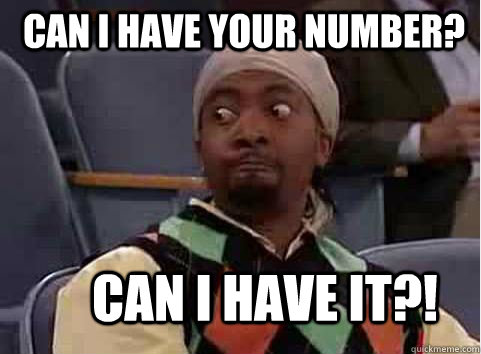
Not in a delightful, ‘Hey, can I have your email because I’ve got a great incentive for you that will be sent to your email now which you will benefit from greatly instantly’ kind of way. But rather, just a ‘hand over your personal contact information now, @#*~%!’ sort of way. Sometimes I feel like I’m being held up at the check out.
Why should I give up my deeply personal contact information if I don’t know a) what your offer is and b) what’s in it for me?
Digital Marketers should be asking the same thing when building out their lead generation strategy. What’s in it for your customers?
Beyond the offer that you’re providing to customers, getting visitors to fork over their personal information and become your lead requires that you provide them with something that will add value to their lives. These incentives can come in the form of educational content like eBooks and guides, digital courses and webinars, or resources like templates, checklists, and presentations, or even in the form of free gift giveaways.
Create compelling content that is worth your audience’s wild, and they’ll be give you their numbah (and email) from left and right.
3. Abide By Form Rules
What should your landing page forms look like? How many fields are too many, too few? Is there even an ideal number?
Just remember this: the number of fields your form uses depends on your offer. The further down the sales funnel your offer, the more details and therefore fields you may require from your leads.
For something as simple as a presentation or use of a free tool, you may only ask for emails. For product demos and webinars, however, you would definitely ask for more information:
- Full Name
- Phone Number
- Title
- Company
The only way to really know, however, is to test, test, test!
4. Use Personalized Testimonials to Build Trust
Adding testimonials to any landing page is going to add credibility to your offer. Word of mouth is perhaps one of the strongest way to persuade someone who is on the fence to buy.
In fact, customer testimonials and reviews have the highest effectiveness rating (89%) for influencing buyers.
Testimonials go further, however, when you add a face to the words and are personalized. Including photos with your testimonials or case studies verifies the human aspect of the testimonial, and asserts it’s honesty.
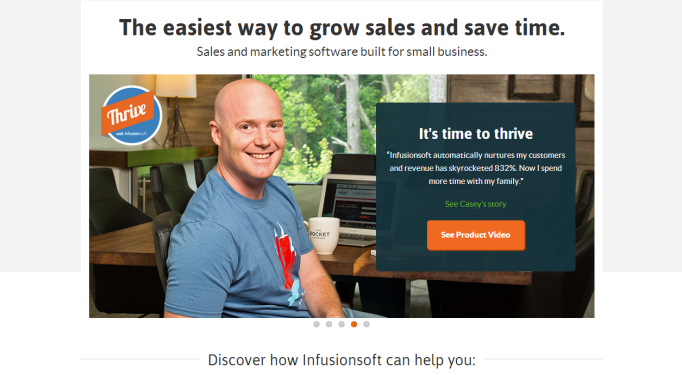
According to MarketingLand, surveys reveal that 71% of marketers see their ROI increase with video ads. That said, it’s worth testing the use of video testimonials to drive leads.

5. Consistently Use an Actionable CTA
Using a strong, actionable CTA consistently for your campaign may be the difference between that final click after the visitor fills out that lead form or just clicking away.
CTA writing best practice is to be specific and describe precisely what will happen once visitors click on the button. Match your message and your action.
Here is an example of a great actionable CTA from Netflix:
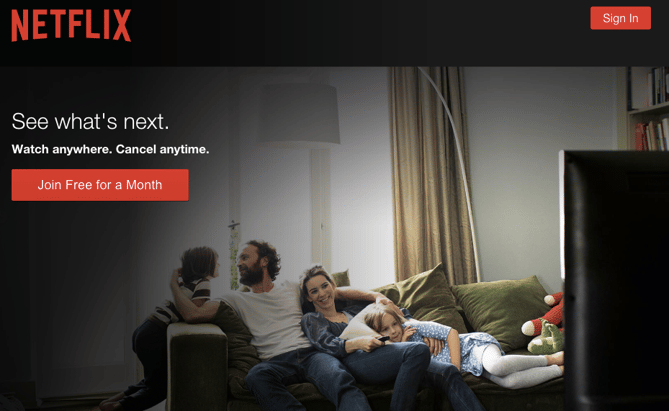
Why is this great?
- Copy is concise
- CTA is specific
- You know exactly what you get when you click
- Clean simple design focuses visitor’s eyes on CTA
- Copy colour and button background colour stand out
Here is a poor CTA example:
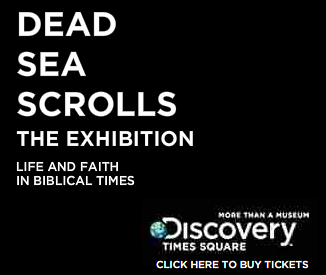
Why does this suck?
- Unclear title makes it unclear what this offer is for
- Where is the CTA button? OH it’s located on the bottom right in font that blends in – viewers can’t even find it!
- If your visitors can’t find your button, they’ll quickly get frustrated and click away – don’t frustrate your viewers!
Keep your CTA relevant, specific, and clear and just watch your leads grow.
And REMEMBER, regardless of the best practice advice you’re receiving out there, there is no better way to get the definitive answer on the right lead generation strategy for your business leads if you don’t test. Test, test, and test! Now go and generate some leads.
http://gph.is/1hAWPrm
Want to learn more? Connect with our team at sales@clearpier.com
How to Most Effectively Retarget Your Customers
Customers subjected to retargeted ads are 70% more likely to convert.
Did you know that customers subjected to retargeting are 70% more likely to complete a conversion compared to non-retargeted visitors.
CTRs for retargeted ads are also significantly higher than regular display (sometimes 10x higher). Those are some impressive stats.
So the question goes: are you retargeting your visitors properly? And I don’t mean, have you got it turned on. I’m saying are you segmenting correctly? Is your frequency cap game on point?
Yes, no, maybe? Say no more! Read on for some great tips on how to most effectively retarget your customers now.
1. Segment everything – literally, everything
Audience segmentation or grouping your visitors based on behaviour is incredibly important for targeting purposes. User behaviour on each of the pages on your site are indicative of the different levels your visitor is at in the buyer journey, and of how of how ready they are to convert.
With this information in tow, you can then create more optimal ad experiences by highlighting the products or services these specific groups previously viewed and directing them back to pages they visited.
For example: Let’s say a visitor viewed both your pricing page and your case studies page, but then wandered off without taking any next steps. While it’s safe to assume they had some interest, you may want to segment them and serve up an ad for your consultation page to catch their interest and re-engage them.
2. Leverage Frequency Caps
When you clicked away, but you're being retargeted with the same ad 50 times a day...
Don’t you hate it when you’ve recently been on a site and then afterwards, no matter where you go on the interwebs, that website follows you around in the form of retargeted ads a million times a day?
Everywhere you turn, at least ten times in an hour, there’s that same exact ad heckling you to buy that one thing you looked at days ago.
Even if a buyer had been interested in the original offer, overexposure can turn a potential convert completely off.
Leverage frequency caps to limit the number of times an ad will be shown to a single visitor so potential buyers don’t tire of your reminder.
Retargeter recommends showing 17-20 ads per month, while ClearPier’s Ad Ops team suggests capping frequency at 3-6 ads/day, particularly if it’s a branded campaign. Terry Kalambalikis, Demand Optimization Manager at ClearPier, reminds us however that this really depends on the type of offer and the needs of the client as well. Different from display, video frequency cap may be set at 1 ad/day, but the smaller cap is also simply the result of fewer avails. Any higher of a frequency cap would affect your pacing.
3. Feel the Burn… Burn Pixel
What might be worst that retargeting without frequency capping? Retargeting the same ad, with an irrelevant message, to a user that has already made a purchase. Your customers are furrowing their eyebrows and asking, “Why are you still trying to sell me this, I’ve already purchased it!”
Your customers RN 'cause, bad retargeting...
Don’t annoy your client base. You want to keep them coming.
To avoid this, use a burn pixel.
Burn pixels is a short line of code that runs on the post-conversion page, usually the ‘thank you page’, will remove users that have already completed a transaction. You can push these users into a different bucket of converted buyers now and serve new ads with more relevant messaging.
The burn code saves you money by helping you reallocate spend. With your audience properly tagged now as an existing customer, rather than a prospective buyer, you can retarget with a new set of ads to upsell, cross-sell or offer new promotions. Previous customers are much more likely to be repeat buyers if you run your retargeting campaigns properly.
So make them feel the burn…pixel!
4. Play with Durations
The duration of your campaign dictates precisely how long your visitor will be retargeted based on their original cookie data. Their retargeting duration can be anything from a day, a week, to a month or longer.
Frequency caps function to limit the number of impressions your visitor will be served throughout your campaign duration. This duration dictates the lifespan of your visitor’s cookie data and at the end of your campaign duration, that cookie is destroyed.
In other words, at the end of your campaign duration, visitors will no longer see your retargeted ads.
Typically longer campaigns run between 30 and 90 days. But beware: even if you have a frequency cap and have set your campaign duration alongside a burn pixel, you NEED to refresh your creatives. Which leads me to my next point…
5. Refresh Your Creatives
Why you ask? People get bored.
YAWN!
This is the biggest risk that can turn off potential buyers that have already indicated that they’re interested in your product or services.
But stale ads are a real problem. What may have appealed to your audience a month ago, may not work a month later.
In fact, Facebook has a subtle way of encouraging advertisers to refresh their ads by slowing down the pacing of an older ad. So, if you want your ads seen and more traffic pushed through, refresh your ads.
6. A/B Test Your Creatives
In addition to refreshing your ads, you should also be A/B testing your creatives to determine which ad is the best performing and eliminate those that don’t.
Testing your creatives will help to uncover which variable of your creative works best. Sometimes all it takes to boost clicks is a button colour change. At others, it’s the image that makes people convert.
If you’re not sure where to start you’re A/B testing, check out our article on A/B Testing 101.
No go forth and start retargeting your audience with confidence!
Want to learn more? Connect with our team at sales@clearpier.com
How to Build Perfect Mobile Landing Pages
If you aren’t using mobile friendly landing pages, you’re losing out on conversions and you’re wasting money. Here’s how to fix that.
Let’s get this straight: mobile landing pages and desktop landing pages are not and should not be the made same. If you aren’t using mobile friendly landing pages, you’re losing out on conversions and you’re wasting money.
You know, we know, everyone knows by now that you have to be on mobile because its a key platform that facilitates numerous touch points along the buyer journey. Google’s data tells us that mobile is the likeliest starting place for online activities, whether it be researching a product through reviews or comparing prices, that can ultimately culminate in a sale down the line. In the past, in the case that research that started on mobile ended in a conversion, that conversion would most commonly occur on desktop.
That’s not the case any more. The growth of mobile commerce is outpacing traditional e-commerce according to ComScore reports. A third of all online sales come from mobile devices now.

So for the sake of winning more conversions, getting more sales, and just plain making more money on mobile, this article breaks down exactly how to build the perfect mobile landing page.
1. Design with Speed in Mind

Mobile users demand instant and easy to digest information that cuts to the chase. They are fast and furious – any latency or slow load times make them agitated and immediately turns them off. Building landing pages for mobile users demands attention to user experience. That means quick load times, short forms, and catchy copy. Make sure you’re optimizing so that you have no slow-loading content.
In same cases, getting rid of images all together in favour of concise copy might work better. Page load times factor into strong user experience which contributes to higher conversion rates overall. Search engines also factor load times into their ranking process as well so keep in mind that slower mobile loading times can throw off your search results and ultimately effect your bottom line.
2. Keep Your Copy Short and Sweet Without Losing Clarity
Keeping your headlines concise is just general good practice. But on mobile, its even more important because of how easily distracted users are. Remember, mobile users are always multitasking and so their attention is already often divided. Don’t distract them further. Worst yet, don’t annoy them by making them have to read so much.
You know this first hand through your own mobile user behaviour. How often do you really read a full article through from A to Z? How often do you just briefly scan a page for the bare minimum info? Why do you think point form listicles are a thing now? Because we live in an age of short attention spans.
Thus, for mobile landing pages headlines should be as short and succinct as possible while all other copy should be minimized. The best way to practice writing clear and concise copy is by writing then editing, over and over and over again until you have the bare minimum that works.
3. Use Strong and Immediate CTAs or Click to Call
Keeping CTAs above-the-fold on mobile landing pages don’t always work, simple due to the variety of screen sizes out there. So the above-the-fold rule doesn’t necessarily always apply. That being said, you should still make sure your CTA is clearly visible and easily clickable by a user’s fingers (and also that it works).
Make sure you’re also optimize for smaller screen sizes. That means making your buttons fairly large. If click-to-call is applicable to your business, swap out your normal CTA for a clickable phone number instead.
Look at the difference between this desktop landing page:
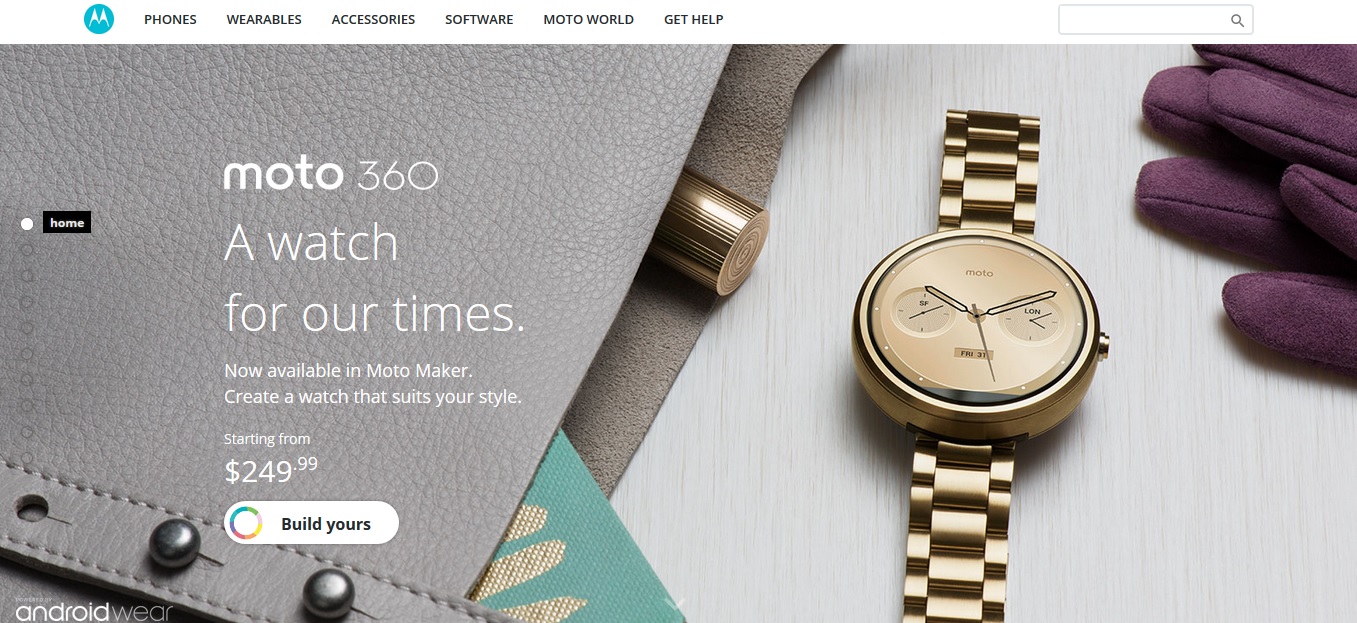
Here is the mobile version:
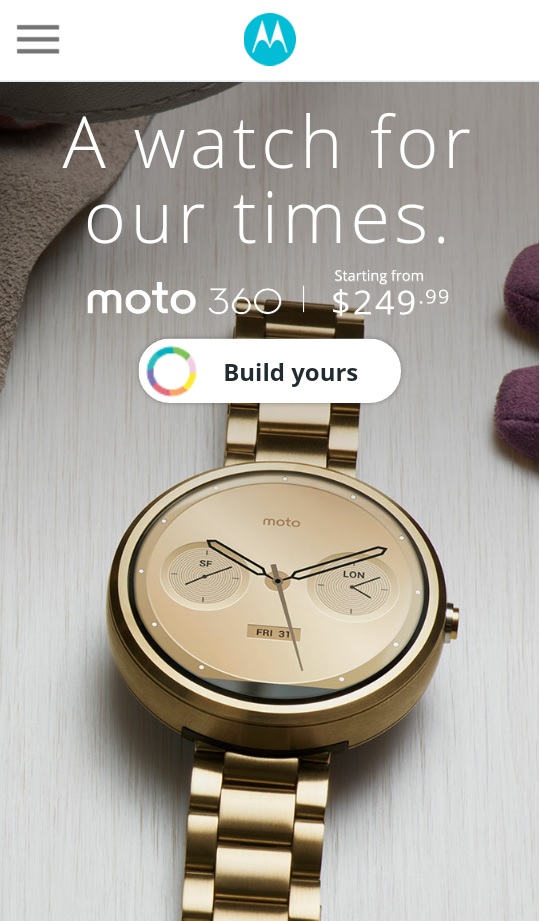
4. Keep Forms Short and Reduce Optional Fields as Much as Possible
We’ve mentioned already that mobile users are really distracted and easily agitated. So unlike on desktop where visitors may be willing to fill out long forms and provide additional information, mobile users are immediately turned off by too many forms.
The reasoning? Screen size. Forms are hard to fill out on small mobile screens what with our giant thumbs and these tiny little fields. Nobody has time for that! Even dropdown menus can be problematic on mobile as well. How often have you been frustrated by dropdown menus and millions of fields on a mobile landing page and just went “Urgh, forget this”? So then you know what I’m saying!
Our advice? Avoid them if you can so that you reduce the likelihood of visitor resistance.
Here’s an excellent reduction of form fields from desktop to mobile:

5. Avoid the One-Size-Fits-All Mentality
Don’t you just hate when you land on a mobile page and you have to pinch the screen to zoom in to see what the message is? Or an image loads and its so big, it doesn’t even fit on the page and then you get distracted about why you even came to the page… and before you know it, you’re out of there.
For the love of conversion, don’t treat your mobile landing pages like desktop. Make sure your designs are either a) responsive or b) adaptive.
A responsive landing page automatically resizes to fit any screen size. With responsive, no matter the device your audience is using they should be able to see your landing page seamlessly across screens which is a good thing because there are multiple user touch points in the buyer process on numerous devices. It’s important the responsive designs for landing pages are used to maintain strong user experience and drive conversion.
Here is an example of responsive landing pages from Skinny Ties.

Adaptive landing pages on the other hand are a little different in that the content of the landing page conforms or “adapts” to the screen size by displaying only the most relevant and important components. Adaptive landing pages are like the nutshell version of a desktop landing page or website.
Here is an example of an adaptive landing page:

Key Takeways
- Optimize your landing pages for fast load times
- Keep copy short and sweet (without sacrificing clarity)
- Use strong CTAs or Click-to-Calls
- Keep your forms short and minimize distractions
- One-size does not fit all landing pages
Keep these key takeaways in mind when you set out to start your next campaign. Build better landing pages and watch your conversions grow.
Want to learn more? Connect with our team at sales@clearpier.com
9 Reasons Why Attracting New Customers is Just Like Dating
Converting high value traffic into customers is an art; the art of courtship.
This week I bet a lot of you are gearing up to woo someone special for Valentine’s Day.
But it’s a challenge, isn’t it? How do you get your desired to notice you, to be willing to give their attention to you, to be interested in you, and to spare their valuable time for you?
For those of us in the business of demand generation and lead nurturing, these questions about dating actually sound a lot like what we ask about our prospective clients.
Attracting new customers is a lot like dating, it’s an art form but it also requires a scientific approach for proper execution. A worthwhile date, after all, strikes a balance between mystery and good planning, leaving your S.O. wanting more.
So what can we learn about attracting new customers from the art of dating?
1. Figure Out What You Want
We all have an ideal guy or girl in mind. Do they have a beautiful golden mane that glistens in the sun? Are they beautifully sculpted like a god? Do they love long walks on the beach and writing wistful poetry that they whisper into your ear at night?

In the dating world, we usually have a general idea of what our ‘type’ is. It should be the same for your marketing.
Get a better understanding of exactly who your ideal customer is by doing some diligent research and asking the right questions. Learn more from your current customer base by sending out surveys. If you’re a B2B, you might ask:
- What’s their role at work?
- What is their day-to-day like?
- What are the biggest work-related challenges they face?
- What’s their educational background?
- What peeves them about vendor products and services?
If you’re a B2C, you might ask:
- What’s their role home?
- Who does the majority of the household purchases?
- What is their day-to-day like?
- What’s the biggest challenge to their day?
- What’s the most important thing a product or service should do for them?
You can interview your customers through email surveys, or by taking your clients out to lunch to get their feedback. If you enable quick surveys to take place just after your signup process, you can immediately retrieve more information from your customers when they are most willing to provide it – when they sign up.
2. Get to Know Your Date
Once you’ve gathered enough information about your current customer’s needs and wants, pause to consider how your business or services fit for them. Then create Buyer Personas for your ideal prospective clients. HubSpot in fact has some great Buyer Persona templates you can use.
Use your imagination. If you can imagine that your ideal guy can wield Mjolnir like its NBD (which means carrying you over the threshold should be a piece of cake), then you can imagine some kick-ass Buyer Personas. Just think of your Buyer Personas, as your ultimate Playbook.

What’s their demographic? What titles do they hold? What’s their backstory? Give them one. What positive things would they say about your product, what are the negatives? What do they really care about? Flesh out your ideal clients and get to know their buyer persona, truly understand what their needs are and what drives them to buy.
The more you know what you want – or rather who you want- to be your customers, that is, the easier it is to woo them.
3. Pursue a Relationship, not a One-Night-Stand
This is usually a pretty daunting task in the dating world. Props to all of you who manage to muster up the courage to walk up to someone at the bar and say “Hey you, want to be friends?” Of course, depending on your line the outcome isn’t always positive.
So how do you get in front of the right audiences during this awkward phase when they don’t know you, they might not even want to get to know you, but you really want to get to know them?
By building a relationship and like all strong relationships, that requires trust. How do you achieve this?
Boost your Content Marketing Strategy. Lead the conversation that should be taking place between you and your audience. Provide prospects with valuable, educational, and actionable content that’s useful. But don’t be pedantic and stay relevant. There’s nothing worse than having a date mansplain, or talk about things that you have absolutely no interest in.
Wait, there is something worse – a date who talks incessantly about nothing but their self. You’ve been on some of those dates, terrible right?
Exactly. Make sure your content marketing strikes a balance between valuable industry relevant content, and promotional “hard sell” content. Ensure your audience understands what your business stands for, your mission and how you benefit them, but don’t just talk about you. The majority of your content should actually consist of high value entertaining or educational material that audiences would enjoy.
4. Be Honest, Be Steadfast, Be a Gentleman
Those are the dating terms. Let’s translate them into marketing terms: be transparent, be consistent, and provide quality service.
This applies across every marketing channel. If you want to build a repertoire with your audience (read: date), then you must be honest. You can’t misrepresent your services and features, and you can’t over promise but under deliver. The second they discover you’re a fraud, say goodbye to dates 2 and 3 and everything else that comes with the third date.
You give your audiences the truth. Negative reviews show up on Yelp? You take that like a champ and you don’t delete those comments. Instead, you show your dedication to audience by acknowledging that feedback and strive to improve your service.
Consistency is also key across every marketing channel. On social media, you got to keep up a consistent conversation. For your content strategy, posting consistently will keep your audiences coming back for more. If you’re running paid ads on websites, make sure you consistently appear on the sites where your audience actually visits.
Consistency keeps you top of mind. It ensures you continue to pay attention to your audience. When you share an article on your blog for your audience, you’re saying “Hey, I was thinking of you and I thought you might like this.” When you “like” what they Tweeted, you’re saying “That’s a great point. I am listening to you.”
And together, that adds up to being attentive to you date, or rather your prospective customers, which is really just good customer service.
5. Don’t Look for Love in the Wrong Places
So you want a relationship. You want to settle down and maybe start a little fam. But for some reason, you are still looking for dates at 3 AM in the club. Come on! You know better than that.
Attracting new customers that you want to have as clients for life, is the same. Get in front of your audience at the right place and the right time and you need to keep your ads relevant. How?
When running programmatic campaigns, you have to ensure your targeting parameters are on point. You’re not going to run your ads for, let’s say Hummers, on a publisher that advocates green energy and environmental friendly lifestyles because you know that the audience reading that publisher is not going to be interested in your ad. That’s a waste of ad dollars.

To target your audiences better, choose to work with a vendor who can help you leverage data from a Data Management Platform (DMP), allowing you to layer audience behavioral and contextual data over your targeting. Better yet, get your hands on some first-party audience data (*ahem* ClearPier offers first-party publisher audience data) so you can segment your audience list and really target your ads.
6. Treat Your Dates as Individuals
You’re dating Sarah. Sarah like to go to the ice cream parlor for milkshakes which she dips into her french fries – she’s quirky like that. You met Sarah at concert. But you’re also seeing Sally who you met at a friend’s party. Sally is lactose intolerant, but she still likes dessert. When you ask Sarah out, you’re going to suggest going to that new hipster ice cream parlor on Queen and Spadina. She’s going to love it, she says yes. So you decide to try the same thing out with Sally. You suggest going to that new hipster ice cream parlor on Queen and Spadina. She, obviously, says no and is a bit turned off by you now.
What went wrong?
You didn’t tailor your messaging!
It’s important to treat each of your customers as individuals and to segment your audience list so that when you communicate with your customers, you’re sending a targeted, relevant, and personalized message. Tailored messages are the only ones your audience will respond to, and it’s the same when it comes to Sally. Here are some creative ways you can segment your audience list.
7. Prove that You’re Actually Worth It
So you’ve been on a few dates now, that is, you have a few customers now. You’ve been keeping up your communication, staying attentive and delighting your customers with brilliant high-value content. Great.
The challenge here is to turn your customers into brand advocates so that you can then ask for feedback and testimonials to continue proving your value. But how?
Actions speak louder than words. First, deliver on the marketing promises that you about your product or services. Remember, provide attentive and quality customer experiences. And finally, appreciate your customers and show them you care.
Before you know it, they’ll be telling the whole world just how great you are.
8. If You Love Them, Let Them Go – But then, Retarget
It’s bound to happen. Your date might just not be that into you right at this moment. That’s okay, let them go. But then, you just got to get back in front of them and remind them of how great you are and they should get back together with you, stat.
Okay, this last analogy might be pushing it a bit. This is one of those few times where dating and marketing aren’t exactly the same. In the real world, applying “retargeting” strategy might be a little creepy.
In the digital marketing world, not so much! The reality is that the customer journey is not linear and often times there’s a long period of research that might take place before conversion actually happens. As marketers, we must be patient. But we can push prospective clients along towards conversion faster with pixel-based retargeting.
But keep this in mind when you’re retargeting:
- Your frequency cap: no one likes to see the same retargeted add too often, following them around the internet wherever they go. Forget that. Put a cap on it. Retargeter recommends no more than 17-20 retargeted ads for your visitor per month.
- Refresh your ads: seeing the same creative every where is terrible. It might even make people clear their cookies – not what we want. In fact, click-through rates can drop by 50% after 5 months of running the same creative. Stop creative fatigue, switch up your ads!
- Segment your audience by stage in the purchasing funnel: the further along they are, the more likely they are to convert (e.g. if they’ve looked at your pricing page). If your visitor has only viewed your home page, they may still be looking for more information. By segmenting your audiences, you can retarget with the right ad to inspire the next action and push your prospects further down the conversion funnel.
9. When They Fall in Love, They’re Your Biggest Fan
Finally, just like in the dating world when your date actually falls in love with you, they become your biggest cheerleader.
The same can be said about prospects who turn into customers. But remember, it’s a relationship and it requires nurture and hard work. For marketers, this means continuing to provide the best customer service possible while listening to your audiences. Keep it up, and they’ll be a fan for life.
Want to learn more? Connect with our team at sales@clearpier.com
How to Choose the Right Marketing Attribution Model
Your Quick Guide to 8 Different Attribution Models
You’ve planned the best campaign you can. You’re going to do a great job executing. But how do you plan on measuring your success?
You’ve got to make sure you’ve chosen the right attribution model, of course. What’s attribution modeling? An attribution model is a set of rules that defines how you credit each conversion or sale at specific consumer touchpoints along the sales funnel.
How do you choose the right marketing attribution model that’s right for you?
Below you’ll find a quick guide to 8 different acquisition attribution models. Keep on reading and discover which attribution model is right for your campaigns.
1. Last Interaction or Last Click Model

The Last Interaction or Last Click Attribution model is a standard in most web analytics. In this model, all credit is assigned to the last event – whether is a click or any other type of interaction a customer had – just before conversion.
Historically, almost all conversions were attributed to the last click and Direct channel (traffic comprised mainly of visitors proactively seeking you out by entering your URL manually). The Last Click model is simple, and for that reason highly appealing. Its easy to track and doesn’t demand advanced technological assistance.
But, assigning all credit to only one channel is an oversimplification of the performance measurement and customer journey. Considering brands run marketing initiatives across multiple channels, single channel attribution fails to take all other traffic generation channels into consideration. For example, visitors may have been driven to your site and converted as a result of social media or by referral.
Last Click gives too much credit to the final event just before conversion, which may not necessarily be the final trigger for conversion. It ultimately undervalues all previous visitor interactions and decisions that pushes a visitor along the decision process towards conversion.
Finally, Last Click neglects to consider the impact of mobile. After all customers are now doing research on mobile well before they convert whether on desktop or mobile. Failure to credit other channels ultimately limit our ability as marketers to optimize each channel’s performance.
So now a day new technologies are quickly making Last Interaction or Last Click attribution modeling obsolete.
2. Last Non-Direct Click Model
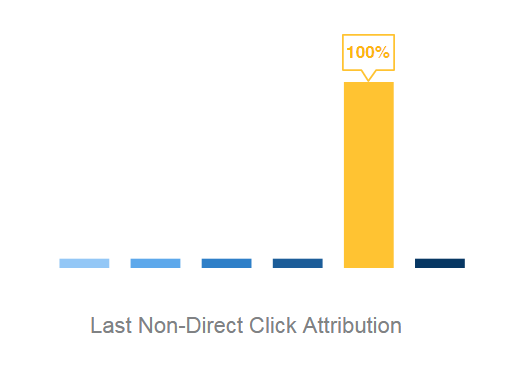
The Last Non-Direct Click Attribution model ignores all direct traffic and gives 100% credit of the conversion to the last channel the customer clicked through before converting. This can be any channel from email to social.
Last Non-Direct Click is a bit more useful than Last-Touch in that it has the potential to correctly give credit to the channel that drove the final conversion, while eliminating the need to deal with ‘Direct’ data which is often a catch-all for all traffic that isn’t properly filtered or tagged.
However, a big downfall of this model is that it completely undervalues Direct traffic, wherein a customer must remember your URL to visit your site and then convert, which in turn undervalues your branding efforts.
If a customer just received a well worded email campaign that prompted them to make a purchase, or they just got a promo code they’re now willing to use, why would any marketer want to give credit to the campaign they interacted with just before this one when it was this one that in fact prompted conversion? You wouldn’t, so most marketers have moved away from this model as well.
3. First Click Attribution Model
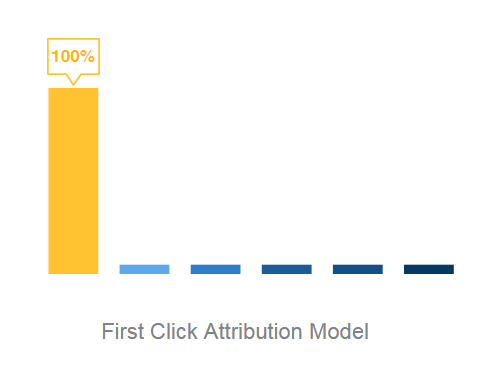 First Click or First Interaction attribution model assigns all credit to the first marketing event before conversion – it is the very opposite of the Last Click attribution model.
First Click or First Interaction attribution model assigns all credit to the first marketing event before conversion – it is the very opposite of the Last Click attribution model.
Again, its another attractive model because its so easy to use. And it does make sense, to an extent: you should definitely value the first customer interaction highly because without it, moving the customer along the decision making journey towards conversion is literally impossible.
But the First Click model doesn’t provide any actionable insight for marketers looking to optimize or measure their efforts. With Last Click attribution, at least we have some confidence in why and how that campaign triggered a conversion. First Click fails to show any data about the decision-making journey and gives too much credit to a single ad click.
4. Last Marketing Channel Touch Attribution

Last Marketing Channel Touch Attribution is channel specific. In other words, in this model, marketers would attribute the last known touch point specific to a channel to a conversion. For example, if you run Search you would use the Last AdWords Touch model. For Facebook, you would use the Last Facebook Touch and so forth.
But you can probably see the problem inherent with this model already: its incredibly biased towards its respective channels. You can easily overvalue the impact of each channel. If a visitor clicked a Search ad one day and then clicked a Facebook ad later in the week and then converted, each model will claim 100% credit for that conversion.
Rather than considering the model separately for each channel, aggregate them into a single report. This will give you a more holistic understanding of the multi-channel touchpoints that lead to a conversion.
The downside with this attribution model, however, is that you will see double or triple counted conversions which adds to your work load to further parse the conversion data.
5. Linear Attribution Model
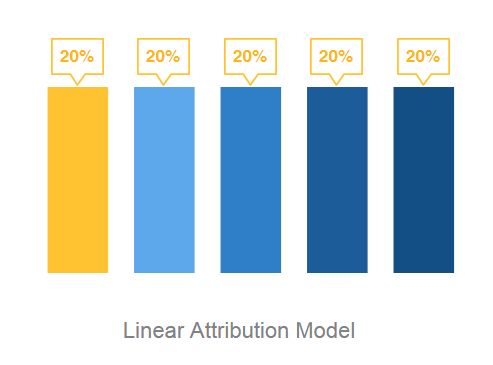
The Linear Attribution model gives each touchpoint along the conversion funnel, for example search, social, retargeting, direct, and email, equal credit for the final conversion.
This model is an improvement on all those we’ve discussed up to this point because it allows for credit to be applied to every single touchpoint along the buyer journey. It’s a simplified multi-touch attribution model.
That’s great! So what’s the problem now, you ask? Disproportionate weighting.
The Linear Attribution model fails to take into consideration the impact of all the other touch points which may have provided more value, and played a bigger role in triggering a conversion.
6. Time Decay Attribution
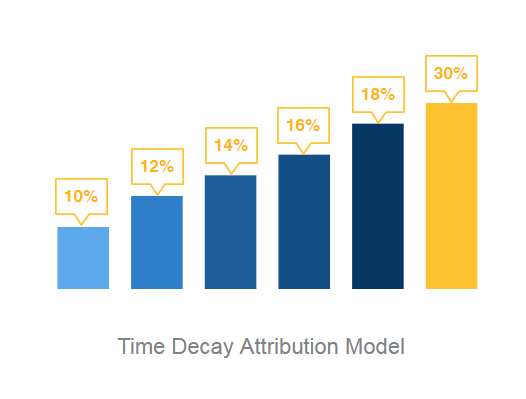
In the Time Decay attribution model, whichever touchpoint closest to the time when the sale or conversion took place receives the highest credit for the conversion. It functions under the assumption that the closer the interaction or click is to a conversion, the greater the impact that interaction had on the conversion.
The argument makes sense. And at least this is a multi-channel/multi-touch channel that also captures the data involved in the long decision making process.
One of its drawbacks, however, is that it may undervalue the heavy lifting that was done by marketing efforts higher up in the funnel which is always located farthest a way from the conversion point.
7. Position Based Attribution
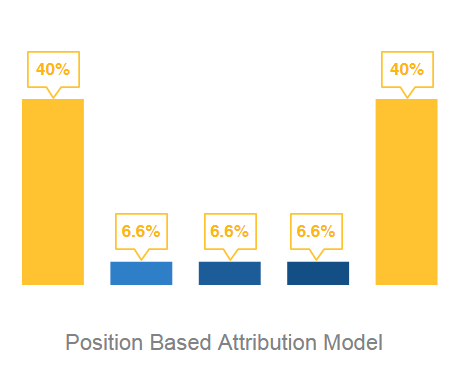
Typically, in the Position Based attribution model, the first interaction and the final interaction in the decision making journey before a conversion is given 40% credit for the conversion, respectively. The remaining 20% is distributed evenly between the other channels along the funnel, but such weighting can and should be adjusted.
The position Based model is a stronger attribution model that takes multiple touchpoints, and multiple channels into consideration. It credits two of the most important customer touchpoints: the first click or interaction (that which introduced the you to the customer) and the final interaction before conversion.
8. Algorithms Based (Custom) Attribution
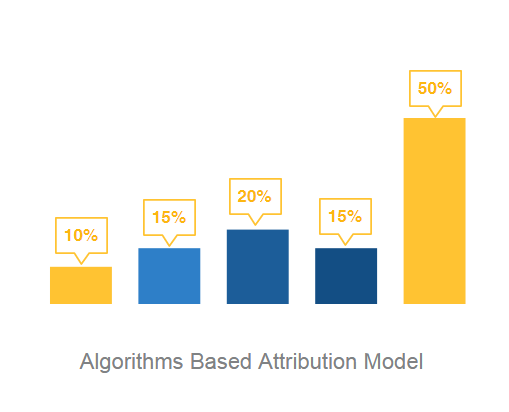
Algorithms or Custom built attribution models assigns credit for the conversion to each touchpoint based on its effectiveness.
This model requires advanced statistically modeling and continued optimization, based on your audience behaviour. It is in fact your existing customer data that will provide the foundations upon which to build your Algorithms attribution model, and understanding of which channel and which step in the decision making journey has the biggest impact on conversion.
The Algorithms attribution model is the most data-driven and provides the most comprehensive customer insight so marketers can identify non-traditional opportunities.
So what’s the final takeaway?
By today’s standards, we should all be steering clear of the First (only) or Last Interaction (only) attribution model. Choosing the right method for you will depend on your marketing needs and the required complexity of your marketing mix.
If it all seems too complicated, not to worry. Start with the simpler Time Decay and Position Based models, although again, avoid First and Last Click. To make attribution modeling of all your marketing campaigns accurate, all your campaigns must also be properly tagged and easily identified so you can give credit to where credit is due.
And finally, don’t just rely on conversion based attribution modeling. Consider other factors, including your CPA, not just conversions. How much does it cost you per acquisition per channel? Is the cost disproportionate to the value of the channel?
Taking all of your marketing efforts into consideration holistically will ultimately help you optimize for stronger campaigns, better targeting by channel and buying behaviour, and reduced spend for maximum performance.
Want to learn more? Connect with our team at sales@clearpier.com
5 Creative Tips for Video Ads that Work
Video ad spend continues to grow driven by its ability to engage and strong
click-through rate at 1.84%.
Did you know that by this time next year, US Digital Video ad spend may hit $11.72 Billion? On a dollar basis, US digital video ad spending is expected to reach $28.08 billion by 2020, up from $9.90 billion in 2016 (eMarketer).
Programmatic video buying is also seeing extensive adoption and growth – accounting for 41% of all Digital Video dollars spent. That represents 58% growth over the past 2 years.
The numbers aren’t surprising considering video’s ability to engage and its strong click-through rates at 1.84% (BI Report).
Video is on the up and up as consumers continue to cut ties to traditional media and turn to digital. Audiences are increasingly discovering content, being entertained, and uncovering new brands through video consumption online, most especially on mobile devices.
As demand for video rises, advertisers need to adapt to the new medium to generate maximum results. Earlier this year, Yahoo and Nielsen & Hunter Qualitative partnered to produce a report on native video advertising that also highlighted some best practices for brands to create stronger video ads.
So how can you find success with video advertising? Here are some of the best tips:
1. Use Large Logos
When it comes to video ads on mobile, the larger the logo the better. Large logos can increase brand familiarity by 24%, affinity to convert by 17%, and brand recommendation increase by 33% according to Yahoo.

For Millennial audiences on mobile, affinity conversion increases by 25% when large logos are used – that’s 11.5x higher than on desktop.
So remember to GO BIG with logos.
2. Always Employ a CTA
Consumer purchase intent increases by 14% for video ads on mobile devices if advertisers employ a call to action (CTA).
Encouraging visitors to take a specific action to take them further along your sales funnel. Whether it’s a sign up, call, or click – CTAs represent lower-funnel metrics like purchase intent and brand recommendation which all help measure your ads performance.

3. Optimize Your Creatives for Mobile
When creating your videos keep in mind that on mobile, you can watch video either horizontally or vertically (including vertical landscape and vertical portrait). Optimizing your video ads for screen alignment is therefore extremely important.
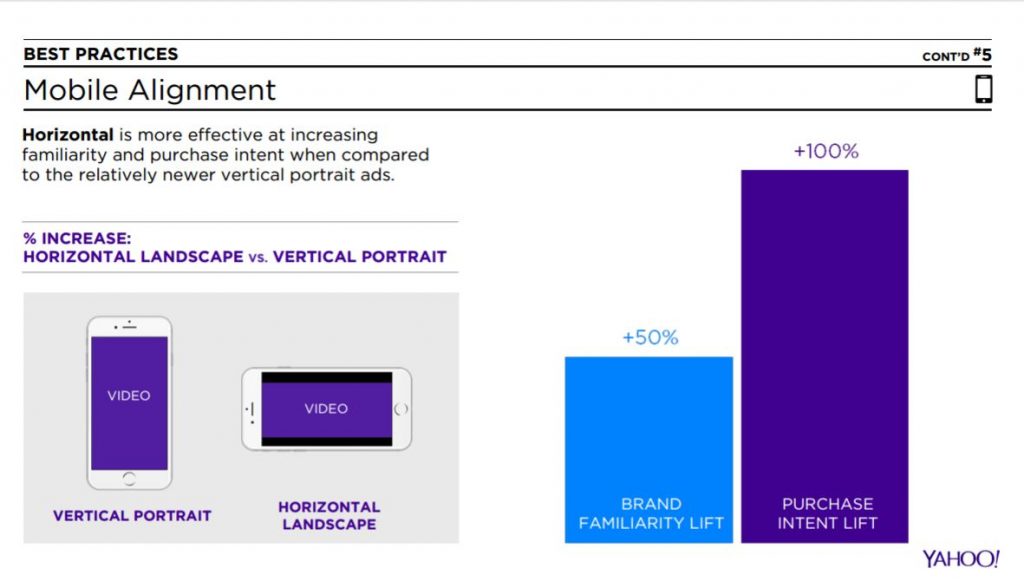 Traditional horizontal landscape videos are the most efficient at driving top and bottom funnel metrics like purchase intent and brand familiarity.
Traditional horizontal landscape videos are the most efficient at driving top and bottom funnel metrics like purchase intent and brand familiarity.
4. Go with Traditional Length for Pre-Roll
We know that the traditional video ad lengths that run for 15-30 seconds work. When videos are shorter, say just 5 seconds, brand affinity conversion, brand recall and purchase intent metrics don’t do so well. 5 seconds may simply not be long enough for audiences to process and recall a brand.
Slightly longer video spots generally perform better, but only if they are entertaining, humorous, interesting, engaging and relevant to the viewer.
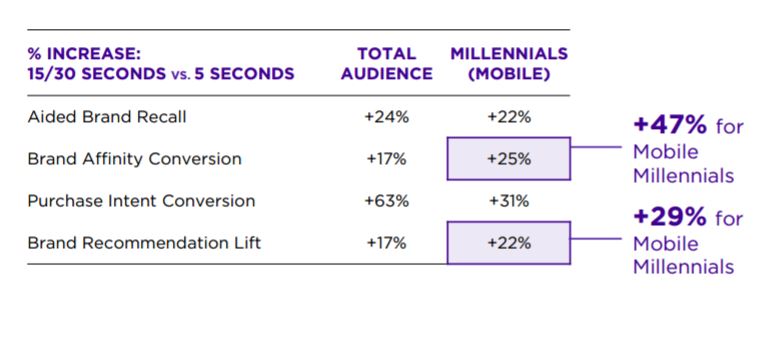
For Native video ads, Yahoo recommends 15 seconds which reportedly drive greater recall and purchase intent.
5. Go Ahead and Auto-Play
Digiday reported earlier this year that 85% of Facebook’s videos are watched without sounds, and other publishers seem to agree.
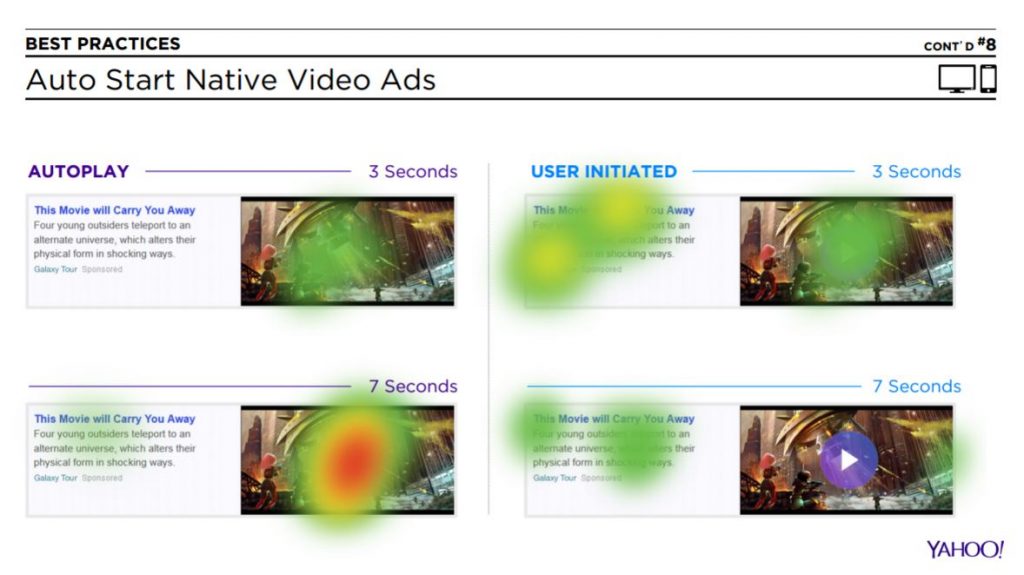
Yahoo advises that auto-pay significantly increases brand recall when compared to user-initiated videos play. Eye tracking indicates that auto-play helps keep viewers focused on the video ad itself, whereas user initiated videos depend more heavily on copy which can negatively impact engagement.
Video ad spend will only grow as the medium matures online and across mobile. But advertisers and brands need to experiment, test and optimize. Just remember to keep these best practices top of mind. Check out the full Yahoo report here.
Learn how ClearPier can improve your video campaigns. Connect with our team at sales@clearpier.com
A/B Testing 101: A Crash Course on Optimization
Without A/B testing -without experimentation- you have no concrete data to drive real growth.
What is A/B Testing and how does it work?
A/B tests are experiments in which two versions of something are compared against each other to see which performs better.
You can A/B test almost anything. Whether it’s an ad, a banner, a button, a landing page, a website, or an app – it can be A/B tested.
When audiences visit your site or app, they are randomly split so that a percentage of users are shown version A, while others are shown version B. Statistical analysis will reveal which version gets the best results.
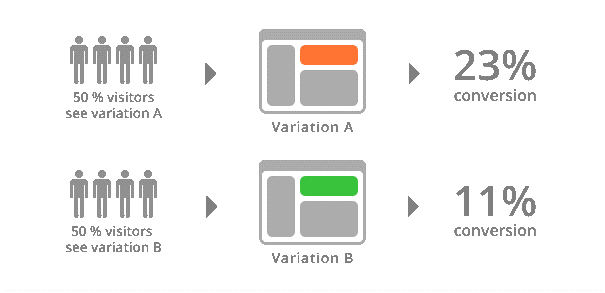
The A/B method lets you test very specific changes to your website, then collect and analyse the data so that the impact of the changes can be measured and lead to data-driven optimization.
The changes can be as simple as a headline (colour, wording) or as extensive as a complete redesign of the page. Then, half of your traffic is shown the original version, while the second half is shown the modified version to see which one gets the results you’re looking for – revenue, signups, downloads – whatever you’re trying to do with your website.
Why Should You A/B Test?
A/B testing may sound simple but the insight gained can lead to significant measurable improvement of the user experience and performance. When it comes to making guesses or assumptions about human behaviour – specifically, how people will interact with your site or app, the results are often unexpected and can only be uncovered through actually testing.
After testing one variable at a time – the cumulative effect of winning changes leads to tremendous boost towards your desired outcome or goals – such as conversion rates.
In addition, the overall spend on marketing can actually be decreased as the elements of the user interface become as efficient and effective as possible – especially when it comes to getting new customers. A/B testing also proves useful to help product developers and designers to optimize other goals such as user engagement, and in-product user experience – to name a few.
Here’s another example of why you should A/B test (for more examples, go to www.behave.org) – the Citizens Bank experiment:
Should your call to action stress urgency or important information?
Key Performance Indicator (KPI): Unique Open Rate (unique opens/net delivered)
Traffic Source: Existing banking customers. Traffic to site split 50/50 between version A and version B.
Goal: to determine which emotional language subject line will convert better – informative or urgent.
Difference between versions:
Version A: Urgent email subject line: “Act now – get help with selling or buying a home”
Version B: Informational email subject line : “Important information about selling or buying a home”


Which version do you think won?
The Winner: VERSION B!
Compared to version A – the informational copy increased open rates 49.2%, at 99% confidence.
Why? Perhaps because urgency in subject lines is a widely used marketing tactic – one that has lost its effectiveness due to overuse. This particular tactic is an old trick – marketers are simply trying to trigger our impulsive instincts and motivate us to purchase or engage in some other call to action.
(Source for Citizens Bank example: BEHAVE, https://www.behave.org/case-study/call-action-stress-urgency-important-information/)
Here’s another example from Highrise, a CRM software company:
Highrise’s Headline & Subheadline Test:
 Highrise tested different headline and sub headline combinations to see how it affected their sign-ups. The test showed that the variation telling visitors that the sign-up is quick produced a 30% increase in clicks. It was also the only variation with an exclamation mark.
Highrise tested different headline and sub headline combinations to see how it affected their sign-ups. The test showed that the variation telling visitors that the sign-up is quick produced a 30% increase in clicks. It was also the only variation with an exclamation mark.
These examples show how A/B testing little changes can lead to big wins. So, what’s the process?
The A/B Testing Process
- Collect data: First, you must analyze and gain insight into where the bottlenecks are – such as pages with low conversion rates or high drop off rates and other user metrics such as page views, time on site, impressions, clicks, CPCs, and many more. Here are four tools to help gain this insight:
- Google Analytics google.ca/analytics
- Mixpanel mixpanel.com
- KISSmetrics kissmetrics.com
- Omniture (Adobe) omniture.com
This information will help to set specific and measurable goals.
- Identify Goals: Figure out what metrics you will use to determine whether (or not) the changes get better results than the original version. Goals can be anything from website visit duration, email campaign signups, viewability of ads – the possibilities are vast and it is important to explore several possibilities before getting too focused as you risk missing the best possible solution. A helpful tip to start off: visit your website and jot down all the actions visitors can perform to create a list of possibilities.
While narrowing down to goals remember that less is more – keep focused and reduce choices so that you’ll get the most accurate results from testing. A straightforward goal example could be to simply optimizing engagement through a 20% increase in email list signups.
- Generate Hypothesis: Now that you know exactly what you want to improve, you can begin hypothesizing about what changes you think would make the biggest impact and then test. If your goal was to get more people to sign up for an email list or form – you could try something as simple as removing a few fields to make the process as painless as possible for the user to encourage more signups. We all know that attention span is short and that no one likes filling out lengthy forms (at least initially while to payoff is unclear). Or, what if your original call to action wasn’t as motivational as expected and your goal is to increase the response rate? For example, you want people to donate, so you might hypothesis that changing the wording from your current call-to-action “contribute” to “please donate” would be more engaging and direct.
- Generate Variations: Here’s where the A/B testing software comes in, which allows you to actually make the desired changes to your website or app and have the ability to see exactly what it will look like (especially helpful when changing colours or moving elements around) . A/B testing software resources include:
- Optimizely optimizely.com (free trail for 30 days, affordable and easiest to get started, real-time support, multi-functional)
- Visual Website Optimizer vwo.com (free trail for 30 days, feature rich, includes idea generation tools)
- Unbounce unbounce.com (focuses solely on landing pages, offers 80+ pre-designed landing page templates)
- KISSmetrics kissmetrics.com (premium, starting at $150 per month with full year commitment, offers advanced abilities, loads of data)
- Conduct Experiments: Let the testing begin! This is the part where visitors will be randomly sent to either the original version or the modified version to test which performs better. The way users interact with each version is monitored and compared to determine how the changes impacted the experience.
- Analyze Results and draw conclusions: You’re A/B testing tool will organize the data for you so you can see how your test version did compared to the original. Hopefully your test result support your hypothesis, but if not then there is still more hypothesising and experimenting fun to be had!
Conclusion
Every business, website, campaign, app, is different and A/B testing shows that common marketing wisdom often doesn’t apply. The advantages of improving conversion rates by A/B testing are well worth the relatively low investment of time and money.
See below for more surprising A/B testing discoveries that will make you want to test everything!
http://blog.granify.com/6-shocking-ab-test-wins-that-increase-conversion/
Want to learn more? Connect with our team at sales@clearpier.com
7 Tips That Will Take Your Programmatic Buying to the Next Level
Knowing your audience at large isn’t enough. You must segment in detail.
Programmatic is all about selling to specific audience segments. Knowing your audience is therefore key to success.
It starts with identifying your audience’s most urgent concerns. Decoding your audience’s main problems will have a profound impact on not just your marketing and messaging, but also on the way you conduct your business overall.
1. Knowing who your audience at large isn’t enough. You must segment in detail.
Audience segments will allow you to clearly define your targeting parameters. Demographics like age, gender and location are great, but they may not be granular enough. For example, say you’re a travel company and you know you have a strong millennial audience. But segment deeper: pockets of your millennial audience may prefer to travel at very specific times of the year and to certain places only. Some may prefer quiet, luxurious retreats, while others prefer extreme outdoor adventures.
Properly segmenting your audiences will allow you to target with more precision and relevancy which are keys to conversion.
2. Understand the Customer Journey

Knowing your audience helps you learn why your audience buys. But getting to know your customer journey helps you determine the how and when they buy.
How do you do this? Make sure that you’re properly tracking your audience’s behaviour and actions as they visit your website. If you work with a DMP, events based data can provide a lot of insight into your audience behaviour.
- Consider the average time spent between first website visit and first conversion. This tells you how long it takes your audience to decide to buy.
- What’s your audience’s pathway towards a conversion? This tells you precisely which pieces of content your audience views before they convert which helps highlight good content from bad.
- Which sales channel results in the highest sales? Knowing your rate of sales per channel helps to identify your best performing channels so you can reallocate your resources to focus on those, or optimize your other channels.
Dissecting all of this will help you optimize your customer’s buying journey and user experience towards more conversion.
3. Set Clear Goals

As with everything in life, setting goals leads to success. The same goes for programmatic buying, so ensure your goals are clear, measurable, and attainable.
Ask yourself and your team, what goals you want to achieve. Do you want to generate more online sales? Or boost brand awareness? Or perhaps you want to influence offline consumer behaviour?
Keep the following KPIs in mind:
- CTR (click-through rates)
- CPA (cost-per-action), CPC (cost-per click) and CPM (cost-per mille)
- Conversions
- App installs
- Viewability
- Reach and frequency
Programmatic buys enable you to measure your audience’s online buying behaviour at nearly every point of the purchasing funnel. Beyond these tangible results, marketers also want to measure brand impact.
While harder to measure, it’s not impossible to correlate. Look to lift in branded searches, social media engagement growth, and attitudes towards your brand as indicators of brand impact even when you’re executing programmatically.
4. Invest in Brand Safety with Premium Inventory

For marketers, there are a number of things that are top of mind when you run a campaign. First, your ad spend budget is finite. You need to make sure that what you spend ensures maximum ROI. Second, your brand reputation is at stake every time you run anything digitally.
So how do you make sure your brand stays safe but you get the most bang for your buck? Invest in your own brand safety and go with premium inventory.
But keep this in mind, not all “premium inventory” are equal. Premium inventory is set within the context of high-quality, brand-safe content – on trusted and reputable properties.
Working with vendors that have exclusive relations with publishers can ensure that your ads only land on these properties. However, for added brand safety look for vendors that provide additional anti-ad fraud security measures. Vendors that work with GeoEdge or Integral Ad Science are concerned with putting your brand safety first.
Demand more from your advertising partners and get a better understanding of how their premium inventory is bought and sold. Ask them which other platforms and exchanges do they work with? The answers will tell you the types of security measures your ad partner has in place to prevent ad fraud and ensure your ad dollars aren’t wasted.
5. Always Employ Data

If you’re running your campaigns without insightful audience data, your ads might as well have never been seen.
The more granular and accurate data you have, the more opportunities you have to improve the accuracy and effectiveness of your campaigns. Data helps determine how well you target, how far reaching your ads are, how many conversions you will achieve, and ultimately, how much revenue you make.
Data can come in the form of 1st party, generally the data you as a marketer collect, 2nd party, non-proprietary data unique data retrieved from a partner, and 3rd party data, aggregated data usually from DMPs that can be built into custom targeting segments.
While each are important on their own, combining your data layers will transform your targeting capabilities and help your campaigns perform better.
6. Use Relevant Creatives
We’ve talked about the significance of relevant creatives before and we’re going to say it again. If your creatives and messaging aren’t relevant, all your audience segmenting and granular targeting parameters are wasted efforts.
If your campaign messaging isn’t relevant to your target audience, it won’t resonate and therefore won’t result in the actions you aimed to stir from your potential customers. Additionally, if you’re always using the same ad copy for your campaigns, you reduce the power of that ad’s ability to persuade.
Split test your creatives, from copy, to images, to the colour of your CTA buttons to optimize for the best results. Refresh your creatives often so you don’t bore your audience.
Consider using Dynamic Creative Optimization platforms (DCO). DCOs can drive better engagement by swapping out components of an ad dynamically, in real time. DCOs can help increase the efficiency of this process, and helps deliver the most relevant creatives depending on your audience’s pass behaviour and targeting parameters.
7. Go Mobile – Now
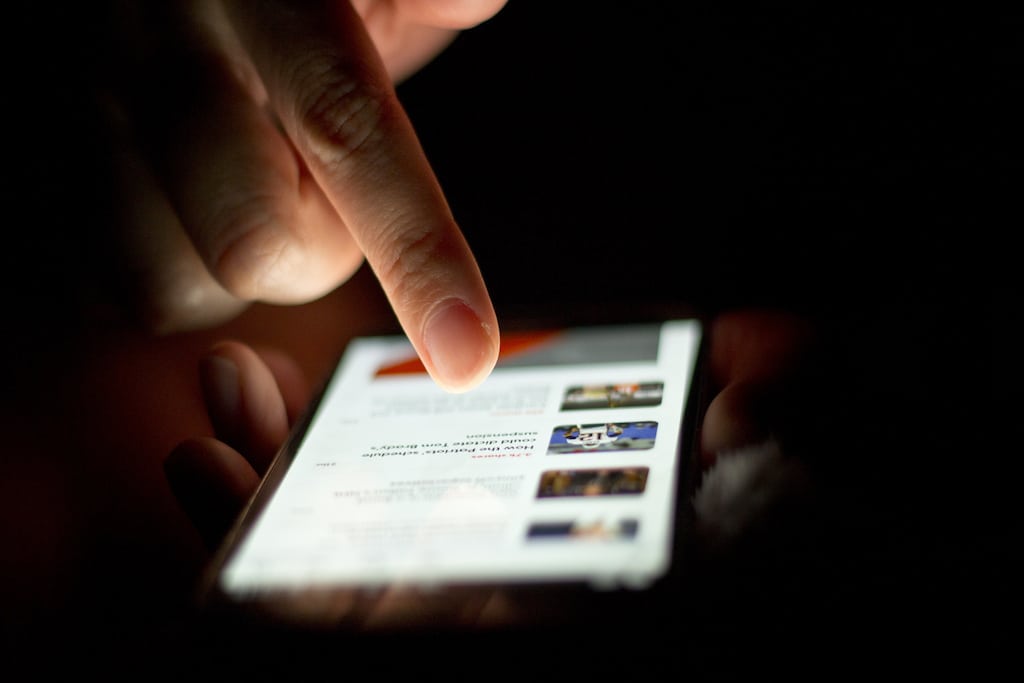
Everyone has gone mobile. That includes your audience. Are you reallocating enough budget to the mobile market? Optimizing for mobile right now may be one of the best things a marketer can do to boost their campaign results.
In 2015, the Pew Research Center estimated that 64% of American adults own a smartphone of some kind. For many, their mobile devices are their primary way of retrieving information.
In the US, programmatic digital display ad spending will reach $22.10 billion this year – an increase of nearly 40% over last year. A big driver of this growth in programmatic spending is mobile and eMarketer predicts that US mobile programmatic ad spend will reach $15.45 billion by the end of the year to represent 69% of all US programmatic digital display ad spend.
The shift towards mobile has been happening for years and marketers must adapt. Realize that the executions that worked on desktop may not work on mobile. Experimentation on the mobile frontier may be what puts you ahead of the competition.
Want to learn more? Connect with our team at sales@clearpier.com.
4 Ways to Optimize Your Holiday Campaigns for Maximum ROI
From segmenting your data to using a CMP; consider the following.
Put away the pumpkin spice lattes, it’s nearly time to switch over to the egg nog. Every good marketer has at this point fully planned and scheduled their holiday marketing strategies. Campaigns are just about ready to launch. But of course, there is always room for improvements.
Before you launch those campaigns, consider the following 4 ways to optimize your performance campaigns for this holiday season.
- Target creatives according to segmented audience data
If you combine the power of compelling creatives with insightful audience data, you can target your audience more precisely and with relevancy. Consumers are much more inclined to engage with ads that are relevant to their needs. The more interruptive the ad, the more likely they’ll put the blinders on.
Let’s take the Amanda Foundation’s fantastic campaign which is a prime example of how useful segmented audience data can be for targeting.
Each of the advertiser’s creatives uses a shelter animal to promote adoptions. But the messaging is uniquely tailored to the audience based on known browsing behaviour/interests, and demographic data.
So if the viewer is a known foodie who loves trying new restaurants, delivering them creative number three would be perfect to inspire engagement.

- Consider using a Creative Management Platform
Creative management platforms (CMPs) are powerful design tools for the programmatic marketer. CMPs are less technical than Dynamic Creative Optimization tools (DCOs) but also allows designers to make large ad sets as well as small changes to individual creatives. CMPs often have pre-set creative templates that cuts down on design time and makes duplication and customization simple.
It’s a scalable creative production environment where you can create and iterate on only the best performers.
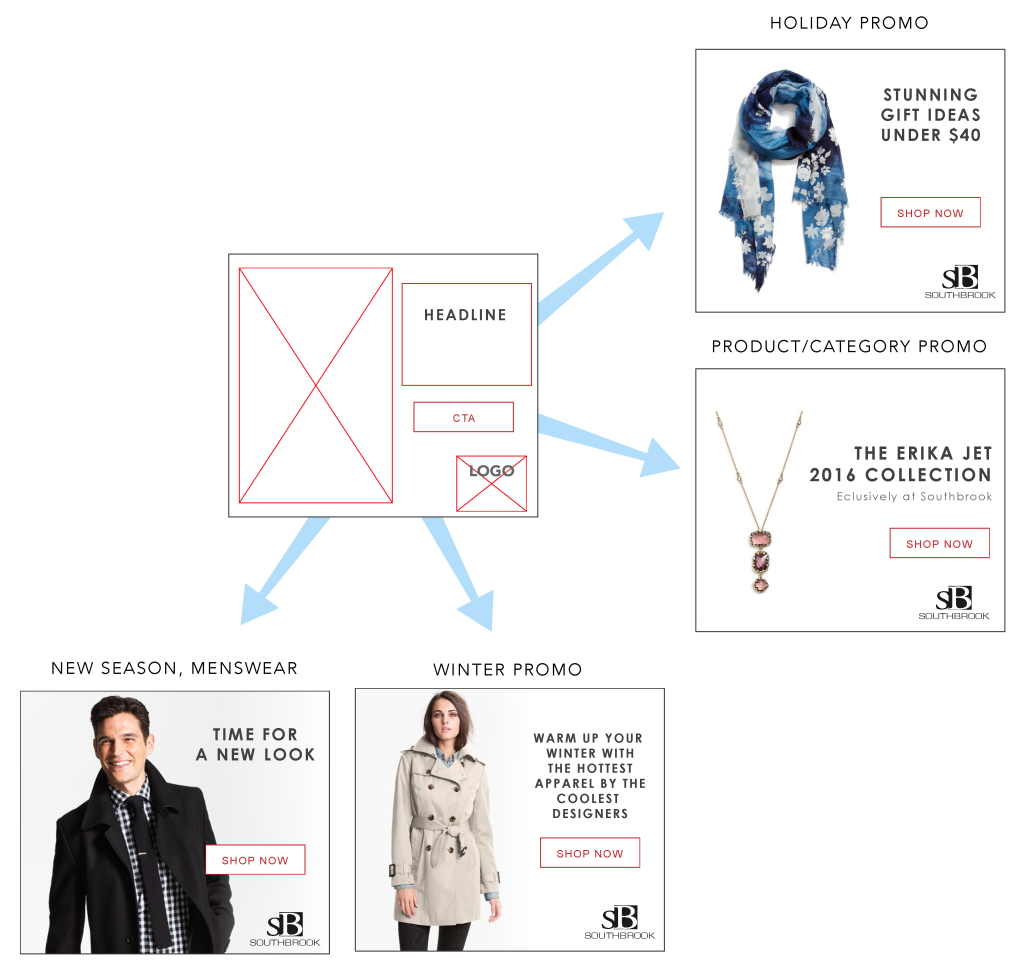
- Remember the importance of “Micro Moments” on mobile
According to Google, 76% of people who conduct a local search on their smartphone visit a business within 24 hours and 28% of those searches results in a purchase. A lot of research is in the pre-sale buyer journey and this will spike as we head into the holiday season.
Google’s series on “I-Want-to-Buy Moments” examined one shopper’s micro-moments (by way of searches, clicks and website visits) over the course of one month to understand how much and how digital research played a role in her purchasing decisions.
The study shows that there are over 1000 digital touch points over a single month leading up to the consumer’s purchase.

Google also shows us the breakdown of her mobile versus desktop search paths:
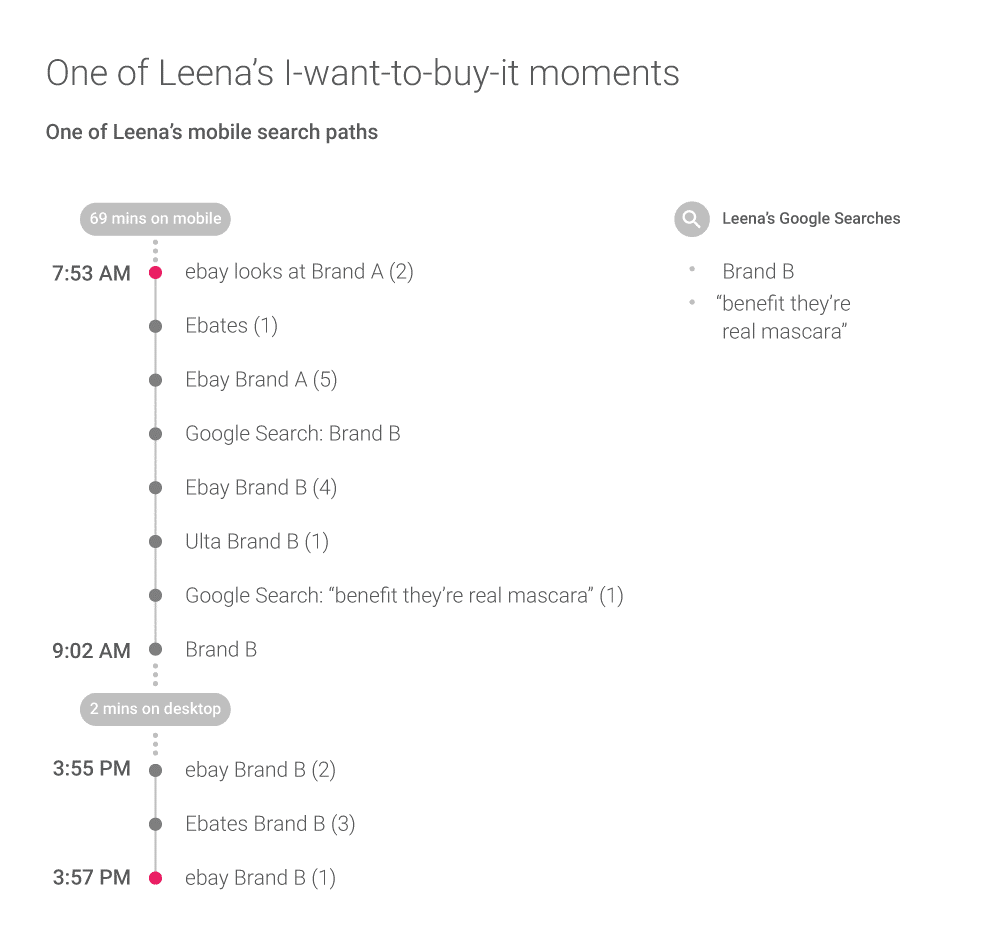 So how can marketers win in these ‘micro-moments’?
So how can marketers win in these ‘micro-moments’?
Be there and be useful. Considering how much research goes into a consumer’s journey now a days, retargeting your ads is a good way to re-engage consumers with buying intent. Remember, although a lot consumers do their research on mobile, buying still happens mainly on desktop. Even upon checkout, marketers can reintroduce promotions, deals, and suggested products for upselling.
- Rotate your ads – or run dynamic creatives
Static banner ads are alright, if they’re well targeted. But banner blindness is indeed a real problem. Keep your visitors curious by rotating fresh creatives in to replace stale ones.
You can up your performance by employing dynamic html5 creatives as well. Why show case only one product, when you can highlight multiple? This is where using a CMP comes in particularly useful as these platforms are often equipped with dynamic creative templates where you simply have to plug in your raw assets.
Best Buy does a really good job at this. Get more out of your ad placement and do more to entice with fresh creatives.

So if you’re not already doing these four things to optimize your campaigns, now is the perfect time to start before the holiday mayhem begins.
Want to learn more? Connect with our team at sales@clearpier.com.



